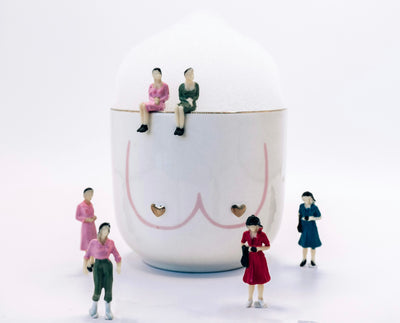Try This Before You Stop Breastfeeding
Try This Before You Stop Breastfeeding
By Katie Black
If your breastfeeding journey is turning out to be more difficult than you thought it would be, you’re not alone. In fact, 60% of women in the U.S. don't breastfeed as long as they want.
There’s endless reasons why you might also be thinking of stopping breastfeeding. Depending on your unique situation, chances are you've tried all your options and nothing sticks. We’re not trying to convince anyone to breastfeed after they’ve already decided they no longer can or want to continue.
However, if you do want to continue breastfeeding but feel like you have no choice but to stop, we put together some things to try before throwing in the (nursing) towel.
Low supply
It’s possible your baby is not hitting certain expected weight for length scores, but is actually getting enough milk. You can often tell by checking their diaper: babies should pee 6-8 times a day with pale yellow urine, and poop 3 or more times a day with loose, seed-like, yellow or tan stools. A baby being alert and active and hitting their behavioral milestones are also signs they’re being fed enough, even if they are on the smaller side.
However, if your doctor has diagnosed your baby as having faltering growth (failure to thrive), you need to take it seriously. But before you stop breastfeeding,
1. Reach out to a lactation consultant immediately. These are trained professionals who are well versed in any problems that can arise while breastfeeding. If you can’t afford one, double check with your insurance to see if it’s covered, or explain your situation and see if you can negotiate the cost with a lactation consultant. It never hurts to ask.
2. Weigh your baby before and after feedings (in the same outfit) with a hospital grade scale. This way you can know the exact amount of ounces your baby is drinking. It’s possible you’re actually making enough milk but it’s not transferring due to a latch issue.
3. Manage stress. Stress is often an overlooked culprit when it comes to supply, and stressing about not making enough milk can make it dip even more.
- Find a therapist. Check if your insurance covers one, or if there’s a non-profit counseling center near you (they often offer sliding scale rates based on your financial situation). If it’s too hard to get out of the house, even virtual appointments can be really helpful.
- Join a new parent group.
- Set boundaries or expectations with people.
- Get out of your head and into your body. When was the last time you did a body scan?
- Name and sit with your emotions and try not to over analyze what you are feeling. Acknowledging how you’re really doing is the first step for change.
4. Nurse more at night. Sleep training is not your friend if you're trying to increase supply. The longer time you go between breastfeeding or pumping, the less milk you’ll produce. Also prolactin, the hormone responsible for lactation, spikes at night.
5. If you need to supplement with formula, or are pumping make sure you’re using breastfeeding safe bottles and pacifiers.
Baby is allergic to/doesn’t like my milk
Firstly, babies can’t be allergic to breast milk. But it’s possible they have an allergy or sensitivity to something in your diet. One culprit is often dairy. Try eliminating it for a few days and see how your baby responds.
Babies are smarter than we think. If your baby is on a nursing strike it’s more likely they can sense you don’t have enough milk in the breast, or there’s a latch issue rather than them simply not liking your milk. If they always refuse your breast, but don’t mind drinking breast milk from a bottle, some women find exclusive pumping is the best way to go.
If they are refusing pumped milk from a bottle, your milk may be high in lipase which can smell and taste bad. To avoid it in the first place, after pumping, put the milk in the fridge instead of directly into the freezer—the slower cooling rate helps. But if you already have a bunch of pumped milk your baby is refusing,
- Despite what a lot of online advice says, don’t scald your milk. This can destroy some vital components like white blood cells and proteins. Only do so as a last resort.
- Mix freshly expressed/most recently stored milk with older milk.
- Add a drop of non-alcohol vanilla extract.
- Defrost milk in the fridge for 24 hours before gently warming in a bottle warmer.
Sometimes babies are fussy, gassy, and cry. Your baby’s behaviors might actually just be normal for babies, and there’s nothing wrong with your breast milk. Formula brands market themselves as being a solution to help your baby sleep through the night, reduce gas, or fussiness, but while those behaviors can be exhausting to deal with, they don’t necessarily mean anything is wrong.
I’m going on a new medication
Some doctors will recommend you stop breastfeeding in an abundance of caution when going on a new medication, even when it is considered generally safe to breastfeed on. Check reliable sources like LactMed and Hale’s Medications and Mothers’ Milk for info on your specific medication, and make sure to advocate for yourself with your healthcare team if you want to continue breastfeeding.
If you’re temporarily going on a medication you shouldn’t take while breastfeeding, you could also consider pumping to keep up supply until treatment is over and the drugs have left your system. The milk can be used for soaps, baths, and more.
I’m returning to work/school
The idea of pumping at your workplace might be daunting, but millions of women have been able to continue breastfeeding while returning to work. The PUMP for Nursing Mothers Act ensures that most workers get reasonable break time and a private space to pump at work for up to one year after giving birth.
However, employers with fewer than 50 employees are not subject to the break time and space requirements if “compliance with the provision would impose an undue hardship”. Keep in mind, the burden of proof lies with the employer—they must provide substantial evidence that compliance would cause significant difficulty or expense. Without proof, your pumping is protected.
Some tips to make the transition easier:
- Make a surplus of milk by pumping and freezing in case your supply drops.
- Make sure you have the correct flange size, and pump settings.
- Do a power pump after work (several short bursts), which mimics cluster feeding. Pumping often doesn’t produce as much milk as breastfeeding, and this can be a way to up supply.
- Mentally prepare yourself for questions or doubts from coworkers or others.
Additional tips: How to Make Pumping on the Job Work for You
I have chronic mastitis
If you have chronic mastitis and are thinking about stopping breastfeeding because of it, you’ve probably already tried things like frequently emptying your breasts, massages, compresses, assessing latch issues with an IBCLC, and undergoing full rounds of antibiotics. So what else can you do?
- Check your clothes for synthetic, or tight fabrics
- Get a referral for a specialist to check out your baby’s anatomy
- Get a referral for a physical therapist for you
- Get screened for mastalgia, hormonally related breast pain
- See if your doctor thinks nifedipine is appropriate, a blood pressure and chest pain medication
- Get screened for other medical issues such as costochondritis, necrotizing fasciitis, or breast cancer
Supplement
Breastfeeding doesn’t have to be all or nothing. Breast milk even in small amounts has tons of benefits, so if you end up needing to supplement with formula, that’s totally fine. Just remember to use breastfeeding safe bottles and pacifiers. And if you decide to switch entirely to formula, remember that at the end of the day, as long as your baby is fed you’re doing enough.






